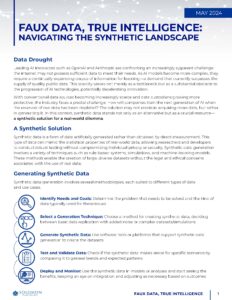Navigating the Synthetic Data Landscape
Faux Data, True Intelligence: Navigating the Synthetic Landscape
 Data Drought
Data Drought
Leading AI innovators such as OpenAI and Anthropic are confronting an increasingly apparent challenge: the internet may not possess sufficient data to meet their needs. As AI models become more complex, they require a continually expanding corpus of information for learning—a demand that currently surpasses the supply of quality public data. This scarcity serves not merely as a bottleneck but as a substantial obstacle to the progression of AI technologies, potentially decelerating innovation.
With conventional data sources becoming increasingly scarce and data custodians growing more protective, the industry faces a pivotal challenge. How will companies train the next generation of AI when the reservoir of raw data has been depleted? The solution may not reside in acquiring more data, but rather in generating it. In this context, synthetic data stands not only as an alternative but as a crucial resource—a synthetic solution for a real-world dilemma.
A Synthetic Solution
Synthetic data is a form of data artificially generated rather than obtained by direct measurement. This type of data can mimic the statistical properties of real-world data, allowing researchers and developers to conduct robust testing without compromising individual privacy or security. Synthetic data generation involves a variety of techniques such as rule-based systems, simulations and machine-learning models. These methods enable the creation of large, diverse datasets without the legal and ethical concerns associated with the use of real data.
Generating Synthetic Data
Synthetic data generation involves several methodologies, each suited to different types of data and use cases.
Identify Needs and Goals: Determine the problem that needs to be solved and the kind of data typically used for these issues
Select a Generation Technique: Choose a method for creating synthetic data, deciding between basic data replication with added noise or complex datasets/simulations
Generate Synthetic Data: Use software tools or platforms that support synthetic data generation to create the datasets
Test and Validate Data: Check if the synthetic data makes sense for specific scenarios by comparing it to general trends and expected patterns
Deploy and Monitor: Use the synthetic data in models or analyses and start seeing the benefits, keeping an eye on integration and adjusting as necessary based on outcomes
Financial Data & Analytics Use Cases for Synthetic Data
Synthetic data plays a transformative role in financial services by providing a safe, scalable, and compliant way to test and develop new financial technologies without the risks associated with real customer data. Here are some pivotal applications:
Fraud Detection
Enables financial institutions to simulate both normal and fraudulent transactions, refining algorithms to detect subtle fraud signals—a crucial tool given the rarity of such transactions
Credit Risk Modeling
Bolsters credit risk assessment by simulating a range of economic conditions and borrower behaviors absent in historical records, helping banks stress-test and anticipate different market scenarios
Regulatory Compliance
Streamlines regulatory compliance by enabling financial institutions to test systems with hypothetical scenarios, preserving privacy and reducing penalty risks without using real-world data
Anti-Money Laundering
Enhances AML model training by simulating evolving tactics, allowing systems to adapt to new scenarios before they emerge in the real world
Customer Journey Analytics
Allows financial institutions to model a customer’s entire journey, from account opening to transactions, enhancing service and personalization without compromising privacy
Outlook
The future of synthetic data in AI and data analytics will be driven by advances in technology that enhance its sophistication, diversity, and realism. However, the challenges of ensuring accuracy and avoiding data misrepresentation loom large, necessitating meticulous validation against real-world scenarios to prevent skewed outcomes. As synthetic data becomes integral to financial institutions and tech companies, it is set to reshape industry standards for privacy, security, and decision-making, broadening its application across various sectors and solidifying its role in the data ecosystem.





